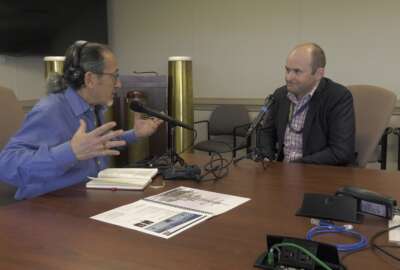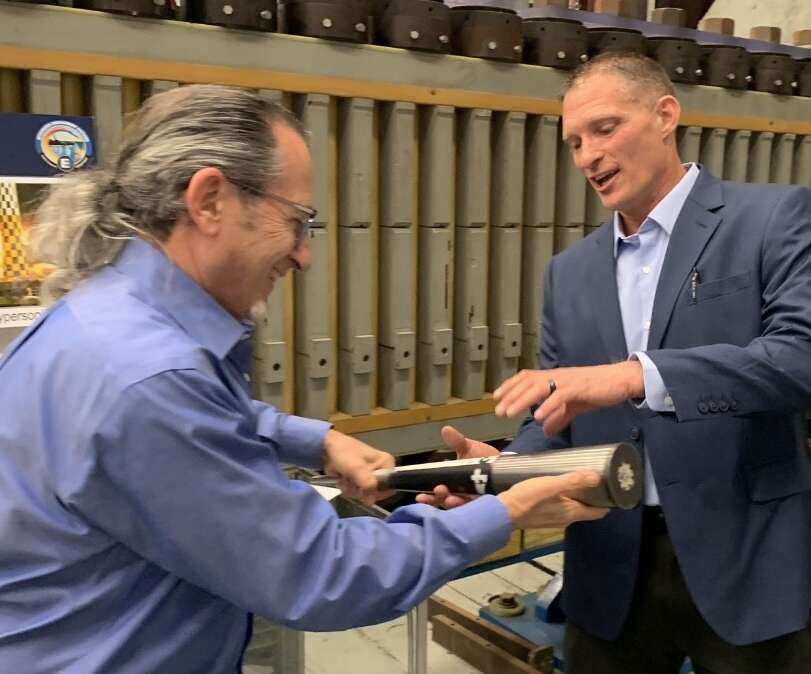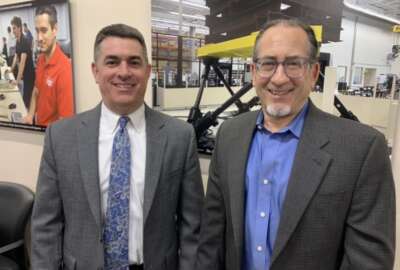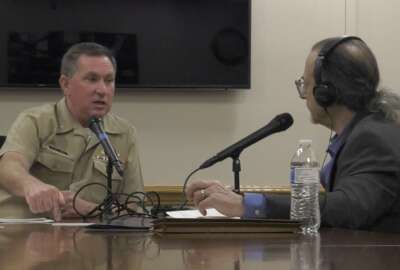
On the gun line at Naval Surface Warfare Center, Dahlgren: New ways to zap the enemy
In the fourth installment of interviews from the Naval Surface Warfare Center Dahlgren Division, we explored two futuristic systems.
Best listening experience is on Chrome, Firefox or Safari. Subscribe to Federal Drive’s daily audio interviews on Apple Podcasts or PodcastOne.
In the fourth installment of interviews from the Naval Surface Warfare Center Dahlgren Division, we explored two futuristic systems. Neither is ready for mounting on the deck of a Navy ship, but both work in advanced laboratory test beds. Adam Jones, head of advanced hypersonics and guided munitions, and Ben Tritt, the chief of Dahlgren’s high energy laser weapons systems, spoke to the Federal Drive with Tom Temin‘s, after demonstrating a laser cutting a big hole in a thick piece of steel.

Interview transcript:
Tom Temin: So is your purpose making two-inch holes and half inch steel?
Ben Tritt: Sometimes it is, but it’s all part of a larger effort. So we have a laser weapon systems division here, a major part of which is this lethality lab in which we do testing on materials and subcomponents and components in order to understand the effect that a laser weapon has on threats, basically. So we can help our designers and engineers and scientists who put together the entire laser weapon system, do it correctly, and then be also capable of predicting how our laser will do in the field against threats. And we also share that information with our partners, other services, other labs, we work closely with the Army and the Air Force, we share results with industry and academia. It’s a total team effort to really develop these cutting edge technologies that we’re developing here.
Tom Temin: What about international partners?
Ben Tritt: So our international partnership is very limited.
Tom Temin: And what is the nature of the workforce? What kind of skills and talents do you need to do this kind of work?
Ben Tritt: That’s a great question. So we have four branches here. We have one branch of about 30 people who focused on laser sources, and also lethality testing. And those are made up of physicists, optomechanical engineers, optical specialists. The second branch we have really gets into the optics and beam control. When the laser leaves its fiber, it needs to be controlled in order to put the right size spot on the target at a great distance. So physicists, electrical engineers, optomechanical engineers, mechanical engineers all work together in a team in order to design a system that can put that laser spot on a target at great distances. And we put these systems on platforms, ships, trucks, you name it. And those platforms like the ships when it’s out at sea, it’s moving. So we have to design systems that compensate for the up and down and left and right movement of the ship at sea, as well as for the tiny vibrations that occur from let’s say, the ship hull, mechanical systems, the engines, the propeller, all of which can really disturb these precise optical systems and cause the laser beam to expand in an unwanted fashion so that we don’t get the right power on the target where we want it. And then our targets are also moving. So we have other engineers and scientists who are working with advanced systems from industry with cameras and tracking systems to be able to track and pick an exact aim point and keep the laser on that aim point until we get the desired effect. That kind of brings us back to this lethality testing that we do in this lab is we work with the military, we work with the warfighter to identify the threats. And then we figure out well what is the material or the subsystem or the system that we want to test. A lot of preparation goes into planning a test. So all of that intel, combined with setting up the laser at the right power, combined with putting the target in its correct configuration, and then figuring out what the desired effect is. You saw an example of just melting through a piece of steel, but we do other materials also. And sometimes it’s not melting. If you think about putting your phone next to a fireplace, it’s gonna get hot, right, and at some point, stop working. Well maybe that’s what we want to happen with whatever this target is. We just want something to stop functioning. That’s another type of lethality test that we can do.
Tom Temin: And just as Dahlgren has a range for shells downriver, you also have a laser range here, too, correct?
Ben Tritt: Yes, so depending upon the size of what we’re testing, and how we’re testing, we might do tests in this building. We might use our 380-foot-long tunnel to do extended range testing indoors. But then if we’re testing a large enough item, let’s say a complete system is what we’re aiming at, we can’t do that in here. We’ll take our lasers and our equipment or an actual laser weapon system that we’ve built out to the range. We can fire across the river over into the experimental explosive area. If we go beyond that we take our systems on the road and go to other locations where we partner, let’s say with the Army, Air Force or academia, to do tests at their locations also.
Tom Temin: And by the way, that tunnel you mentioned that has a history too, doesn’t it?
Ben Tritt: Yeah, it’s an interesting history. It dates back to at least World War II when it was used for people to walk down safely while machine gunfire continued outside. They’ve replaced the targets quickly and go back into the tunnel to allow the firing to resume quickly and not waste the time to walk down 382 feet without firing.
Tom Temin: And every time you test the laser, does it go dark or brown out in King George County?
Ben Tritt: No. Fortunately, the base has done a great job investing into upgrades like this building, connecting it to the tunnel, and then providing us with the power we need to operate these lasers.
Tom Temin: And fair to say one of the operational or deployment challenges aboard a ship will be power I imagine.
Ben Tritt: So that’s another part of our team. I mentioned, we have the laser experts, the beam control experts, the optical experts, but we also have mechanical and electrical and systems engineers who know how to tie the entire system together. So it’s not just the power to it, but also the heat rejection, cooling of the entire system to allow it to operate. And the final piece of our team is also software because all weapon systems are software controlled. And we have a whole team that designs the software that the warfighters use. So the operator interface, and then also we team with other parts of Dahlgren to do fire control software and integrate our laser weapon systems into the combat system, for example, of the ships that we’re putting these weapons on.
Tom Temin: I’ve got a whole box of old computers I have to dispose off. If I brought them down here could they all get zapped as part of your tests?
Ben Tritt: You’d have to pay us, yeah.

Tom Temin: That was Ben Tritt, the chief of Dahlgren’s high energy laser weapons systems. Next I spoke with Adam Jones, head of advanced hypersonics and guided munitions. You focus on the hypersonic question as a system more than as a bullet that goes fast or launch system, correct?
Adam Jones: That’s right. It’s all part of a bigger weapon system integration effort in my mind. We develop weapons here, NSWC Dahlgren. Part of our job is to ensure that these new advanced weapons are integrated properly aboard our platforms.
Tom Temin: And right now we’re standing next to a railgun. And it’s quite long, and there’s a whole room full of gear here. Clearly, this could not go on a ship. So tell us about the facility that you have here and what it is you do with it.
Adam Jones: So this facility is part of our effort here at NSWC Dahlgren to kind of reinvent the range, relook at new technologies that are coming up, hypersonics being one of those, and this facility deemed high rise, a hypersonic research and integration for surface engagement facility is intended to look at a number of different challenges in hypersonics flight. Some S&T pieces, like weather impact, lethality impact, there’s also some neurosciences, aerothermal things that we’d like to learn out of this facility to the be all, end all is look at the integration and the weapon system integration of these weapons aboard our platforms where we’ll have hardware in the loop capabilities. And we’ll have some instrumentation and T&E things down on the other end of the site. Now the railgun’s part of our T&E piece here because we have a long history of working electromagnetic launch, aka railgun here at Dalhgren, and we’re repurposing these assets for testing purposes to be able to achieve cheap hypersonic flight. We can fire routinely here at Dahlgren, 10 shots a day here on the range at hypersonic speeds. So the ability to fire 30-pound projectiles downrange and collect data on those is what we’re going to use this for.
Tom Temin: And the collection of data takes place in the cone-shape projectile you developed here. So that’s not a weapons platform, but it’s a hypersonic data gathering type of platform, correct?
Adam Jones: That’s correct. Yeah so we develop electronics, and we develop sensors, and packages that go into slugs or aerodynamic shaped projectiles to gather pertinent data for the hypersonics community. And they’re modeling and simulation and design tools.
Tom Temin: And hypersonics is not new, is it? I mean, it’s in the news a lot and Russia said they have it and China says they have it. So all of a sudden, everybody’s talking hypersonics. Dahlgren has a history of hypersonics that goes back decades, correct?
Adam Jones: That’s correct. Hypersonics is not new to Dahlgren. We have 70-plus years of working in that regime. Hypersonics to us, is an adjective. It’s not a noun. You know, we have a history of working in that flight regime. It’s defined as Mach 5 and above. So submarine launched ballistic missiles re-entry vehicles, standard missile, projectiles, railgun – we have a long history of working in that flight regime.
Tom Temin: And railgun is one methodology. Are you also working on the engine type of accelerator, too?
Adam Jones: Right now the railgun is definitely a big piece of that. As far as data and instrumentation perspective, we have worked efforts in the past that look at ramjet/scramjet technology. We were working with industry partners on some testing of those technologies currently.
Tom Temin: And with the data gathering hyper cone, you recently did a kind of record launch. Tell us about that one.
Adam Jones: Yeah, we’re really proud of that effort. It’s a good hands-on effort for our engineers here at Dahlgren. We were able to leverage our hypervelocity projectile experience that we have here at Dahlgren and design a new, what we call the hyper cone, a little simpler version of the hypervelocity projectile. We designed, instrumented, built several, fabricated several of these within a six-month timeframe. Using our junior and senior engineers here on the base. Took those projectiles down to White Sands Missile Range in New Mexico, and fired these out of our railgun that we have out there at that test site and fired at 209 nautical miles of range, which is a world record for most projectiles.
Tom Temin: And that range already is to the point of where it would be tactically important when the deployment days finally come.
Adam Jones: Those ranges certainly could be depending on what type of system what you’re looking at, what type of mission that you’re looking at that range could definitely be a relevant range.
Tom Temin: And if you put a wedge under that railgun that you launch that from, how far do you think it could have gone?
Adam Jones: Well, that gun out there is elevatable. We have this gun here, which is obviously fixed elevation. That gun at White Sands Missile Range, we are able to elevate the gun.
Tom Temin: All right, and what is the big challenge? What’s the one grand challenge between what we’re seeing here on the floor and all the pieces in the testbed and a shipboard, reliable hypersonic that we could scare the bad guys with?
Adam Jones: I think there are a number of challenges. But I think the key one that we’re trying to solve here is, we know there have been a number of successes demonstrating hypersonic technology here in the United States, with our industry partners, and our DoD partners. But the key piece here is to ensure that we have the end state in mind when we design these systems. So we have to really consider the platform integration pieces of hypersonics. We have to be able to have the system work within our combat systems. It has to work on the right platform. We have to have the right level of integration expertise and ensure all the interfaces are correct so that we make the right acquisition decisions moving forward down the road.
Tom Temin: But in the meantime, NAVSEA really wants this.
Adam Jones: Oh absolutely. Hypersonics is an enabler. Speed, better lethality and impact, more range, quicker time to range, more maneuverability. There are a whole host of reasons why we wouldn’t want to explore hypersonics for our weapons here for the Navy.
Copyright © 2025 Federal News Network. All rights reserved. This website is not intended for users located within the European Economic Area.
Tom Temin is host of the Federal Drive and has been providing insight on federal technology and management issues for more than 30 years.
Follow @tteminWFED





